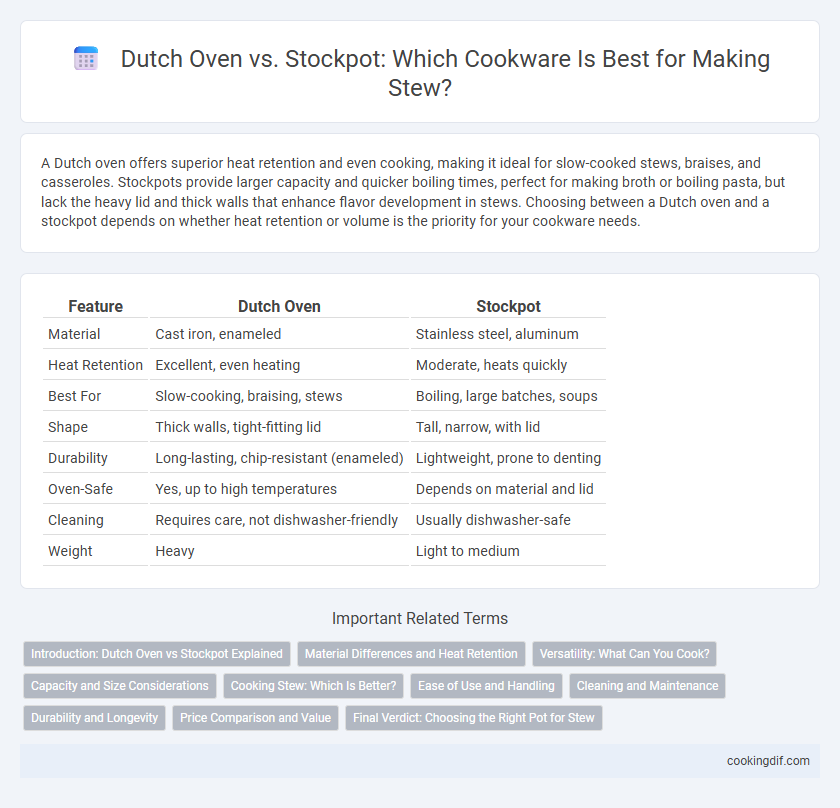A Dutch oven offers superior heat retention and even cooking, making it ideal for slow-cooked stews, braises, and casseroles. Stockpots provide larger capacity and quicker boiling times, perfect for making broth or boiling pasta, but lack the heavy lid and thick walls that enhance flavor development in stews. Choosing between a Dutch oven and a stockpot depends on whether heat retention or volume is the priority for your cookware needs.
Table of Comparison
| Feature | Dutch Oven | Stockpot |
|---|---|---|
| Material | Cast iron, enameled | Stainless steel, aluminum |
| Heat Retention | Excellent, even heating | Moderate, heats quickly |
| Best For | Slow-cooking, braising, stews | Boiling, large batches, soups |
| Shape | Thick walls, tight-fitting lid | Tall, narrow, with lid |
| Durability | Long-lasting, chip-resistant (enameled) | Lightweight, prone to denting |
| Oven-Safe | Yes, up to high temperatures | Depends on material and lid |
| Cleaning | Requires care, not dishwasher-friendly | Usually dishwasher-safe |
| Weight | Heavy | Light to medium |
Introduction: Dutch Oven vs Stockpot Explained
Dutch ovens are thick-walled, heavy pots, typically made of cast iron, renowned for even heat distribution and excellent heat retention, making them ideal for slow-cooking stews. Stockpots, usually lighter and taller with thinner walls, excel at boiling liquids and large-volume cooking but lack the thermal mass to maintain steady low heat needed for rich stew development. Choosing between a Dutch oven and a stockpot depends on the cooking technique and desired stew texture, where Dutch ovens provide superior results for simmered, tender stews.
Material Differences and Heat Retention
Dutch ovens feature thick cast iron construction that excels in even heat distribution and superior heat retention, perfectly suited for slow-cooked stews. Stockpots, typically made from stainless steel or aluminum, heat quickly but lack the same level of thermal mass, resulting in faster temperature changes. The cast iron material of Dutch ovens ensures consistent simmering, while stockpots are more prone to heat loss, affecting stew texture and flavor development.
Versatility: What Can You Cook?
Dutch ovens offer exceptional versatility for cooking stews, braises, soups, and even baking bread thanks to their thick, heat-retentive cast iron construction. Stockpots excel in preparing large-volume dishes like stocks, broths, and boiling pasta, but lack the searing and slow-cooking capabilities essential for complex stews. Choosing between a Dutch oven and a stockpot depends on whether you prioritize multi-functional cooking versatility or high-capacity liquid preparation.
Capacity and Size Considerations
When choosing between a Dutch oven and a stockpot for stew, capacity and size are crucial factors to consider. Dutch ovens typically range from 4 to 7 quarts, ideal for small to medium batches, offering excellent heat retention and even cooking. Stockpots, with capacities often exceeding 8 quarts, accommodate larger quantities and are suitable for big families or parties but may lack the same level of heat distribution found in Dutch ovens.
Cooking Stew: Which Is Better?
A Dutch oven excels in cooking stew due to its thick, heavy construction that ensures even heat distribution and retention, allowing for slow, consistent simmering that tenderizes meat and melds flavors deeply. Stockpots, while larger and ideal for boiling or making large batches, lack the superior heat retention and tight-fitting lid needed to develop the rich, concentrated flavors typical of a well-cooked stew. For optimal stew results, a cast-iron Dutch oven remains the preferred choice among professional chefs and home cooks alike.
Ease of Use and Handling
Dutch ovens offer superior ease of use and handling due to their heavy cast iron construction, which provides excellent heat retention and even cooking. Their thick walls and tight-fitting lids help maintain moisture, making them ideal for long-simmering stews with minimal stirring. Stockpots are generally lighter and easier to maneuver but may require more attention to prevent uneven cooking and evaporation during extended simmering.
Cleaning and Maintenance
Dutch ovens feature enameled surfaces that resist stains and require minimal seasoning, making cleaning straightforward and less time-consuming. Stockpots, typically made from stainless steel, demand regular scrubbing to remove food residues and occasional polishing to maintain shine. Both cookware types are dishwasher-safe, but hand washing is recommended to preserve their finish and extend durability.
Durability and Longevity
Dutch ovens, typically made from cast iron with an enamel coating, offer exceptional durability and can last for decades with proper care, resisting chipping and warping even under high heat. Stockpots, usually crafted from stainless steel or aluminum, provide good longevity but are more prone to dents and less effective in retaining heat evenly compared to Dutch ovens. The thick walls and heavy lids of Dutch ovens ensure consistent heat retention and prolonged use, making them a superior choice for long-lasting stew cookware.
Price Comparison and Value
Dutch ovens generally have a higher upfront cost than stockpots but offer superior heat retention and versatility, making them ideal for slow-cooked stews. Stockpots are more affordable and suitable for larger batches, though they may lack the even heat distribution of cast iron Dutch ovens. Investing in a Dutch oven provides long-term value through durability and enhanced flavor development in stews, justifying the initial price difference.
Final Verdict: Choosing the Right Pot for Stew
A Dutch oven's thick cast iron construction offers superior heat retention and even cooking, ideal for slow-simmered stews that develop deep flavors. Stockpots provide larger capacity and quicker boiling times, making them suitable for large batches or brothy stews requiring rapid temperature changes. For rich, tender stews with complex flavor profiles, the Dutch oven emerges as the preferred choice, while stockpots excel in volume and convenience.
Dutch Oven vs Stockpot for cookware Infographic

 cookingdif.com
cookingdif.com